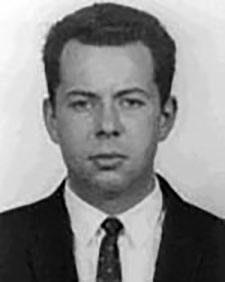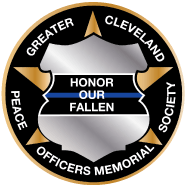
END OF WATCH: July 23, 1968
Cleveland Police Department
Age: 30
On the evening of July 23, 1968, Cleveland Police Officers, Louis Golonka and Williard Wolff, and Lieutenant Leroy Jones were killed following their response to an “all units” call to a gun battle along Lakeview Avenue between Beulah Avenue and Auburndale. Between 8:30 p.m. and 10:00 p.m. seven people lay dead and fifteen others wounded, ten of whom were police officers. This was the first of five days of racial violence in Cleveland’s Glenville neighborhood. Unlike other riots in the United States during the 1965-1968 Civil Rights movement, black citizens in Cleveland fired directly at police.
According to “Shoot-out in Cleveland: Black Militants and the Police, July 23, 1968, Report to the National Commission on the Causes and Prevention of Violence,” after extensive investigation, the question, who fired the first shot, remains unanswered. Also, the report noted that the fighting that erupted in Cleveland’s streets could have happened in any American city.
Around 8:20 p.m. on the evening of July 23, 1968, Tow Truck #58 operators, William McMillan and Roy Benslay, arrived on Beulah Avenue. Unarmed civilians, McMillan and Benslay, wore uniforms similar to police personnel. They were responding to a report made earlier that day of an abandoned Cadillac. As McMillan checked the license plate number, he was shot three times. At 8:30 p.m., an “all units” call was broadcast, and an estimated fifty police officers from throughout the city left their regular patrol and rushed to the Lakeview area. Patrolmen Joseph McManamon and Chester Szukalski drove north up East 123rd Street, and, just as they pulled in front of the tow truck, shots struck their car. Both officers crawled out of the driver’s side, and Szukalski was hit three times and McManamon was wounded by fragments of the bullet that broke Szukalski’s leg. They were rescued fifteen minutes later from the intense gunfire. Patrolmen Torak and Golonka responded to the broadcast of “Policemen being shot at” at East 123rd and Beulah. They were joined by other police officers and proceeded on foot. Police pursued snipers into an alley parallel to Lakeview and began exchanging gunfire. Patrolman Louis Golonka was shot in the chest and killed by several
Shotgun blasts in a backyard between 1389 and 1392 Lakeview Road. He was conveyed by car #417 to Forest City Hospital, where he was officially pronounced dead at 8:40 p.m.
Patrolmen Kenneth Gibbons and Willard Wolff, in car 505, were the first to respond to the call for assistance at a gun battle being waged at the intersection of Auburndale and Lakeview. As they left their car to assist a plainclothes officer with a recalcitrant youth, a high-powered bullet hit the motor and the car exploded. Gibbons was shot and seriously injured. Wolff was shot and died of gunshot wounds to the face. He was officially pronounced dead at 11:05 p.m. at Lakeside Hospital.
Lieutenant Leroy Jones and Sergeant Gentile heard the call for assistance and entered the battle area from East 124th Street. On foot, Lieut. Jones turned the corner onto Auburndale and was felled by heavy gunfire. Unable to get to his wounded partner, Sgt. Gentile looked on helplessly. Patrolmen Angelo SantaMaria and Steve Sopko rushed to the scene. They separated and SantaMaria ran behind the houses on Auburndale. He saw Lieut. Jones lying on the sidewalk and asked for a volunteer among the neighborhood bystanders to drive a car alongside Jones so that he could drag him into the car. A smoke bomb was set off for cover, and civilian James E. Chapman and SantaMaria tried to get a car. As SantaMaria started to drag Jones out, he was shot in the back. Patrolman Steven Marenchy was able to drag Santa Maria to the safety of a police car. James Chapman died from a massive head wound fired from an automatic weapon. Lieutenant Jones died of multiple gunshot wounds at Mt. Sinai Hospital about 10:00 p.m.
At the time of Lieut. Jones’s death, ten Cleveland officers had been seriously injured and conveyed to area hospitals. In the early morning hours of July 14, Governor James Rhodes mobilized all Ohio National Guard units and at 3:00 a.m. two hundred guardsmen were deployed to the Glenville area.
Shortly after midnight, Fred Evans, leader and founder of a black nationalist organization called New Libya, gave himself up to Sergeant Ronald Heinz and Patrolmen David Hicks and John Cullen. The Cleveland Press reported the next day that fifty-one persons were arrested, three of whom were youths occupying a second floor room with three rifles and two hundred rounds of ammunition. Mayor Carl B. Stokes said he believed that this tragedy was instigated by a small organized group. The Plain Dealer reported witnesses described the gunmen as black nationalists who began firing on a police tow truck crew in an unprovoked attack. Residents said they were alarmed by the presence of the armed men in their neighborhood. Police officers said gang members were armed with automatic-firing Army carbines.
The National Commission Report stated that the 8:30 p.m. “all units” call was met by anxious and enthusiastic officers who rushed into the area without knowing precisely, or even generally, the extent of danger waiting. They knew their fellow officers were being assaulted by gunfire and needed assistance. Within fifteen minutes, three officers were fatally wounded. All three were dedicated, highly respected law-enforcement officers. All three officers were devoted family men.
Patrol Officer Louis Golonka of Park West Oval in Cleveland, was survived by his wife Janet and three children, Cynthia, 9; Louis, Jr., 6; and John, 3.
He graduated from John Adams High School in 1953, served four years in the Navy, and joined the Cleveland Police Department in 1959. In The Plain Dealer, Louis’s brother, Kenneth, described his brother as a devoted husband who called his wife every night when he was on duty. “He made his usual call to Janet at 6:30 last night, just a couple of hours before he was shot.” Kenneth went on to say that he tried to persuade Louis to get a better paying job in industry but Louis liked being a policeman. “He knew danger and respected it.” During the Hough riots of 1966, Officer Golonka barely missed getting hit by a flaming Molotov cocktail.
Patrol Officer Willard Wolff, 30, of West 73rd Street in Cleveland, was survived by his wife Elaine and three children, Cheryl, 10, Lori, 7, and Edward, 3.
He graduated from West Tech High School in 1956 and joined the Cleveland Police Department in 1963. The Plain Dealer reported that he was well-liked by his colleagues at the Fifth District because of his bright personality and good humor. “He was so happy-go-lucky,” said Patrolman John Spath. “He never knocked his job or complained. Will kept us all in good spirits.” Officer Wolff’s friend and neighbor, Mrs. Robert Gahdos said he was instrumental in mediating arguments between neighbors and in promoting good-will in the neighborhood.
Lieutenant Leroy Jones of Brecksville, was survived by his wife, Albine, and two daughters, Dana Lee Ita, 21, and Rhea, 17. Lieut. Jones graduated from John Adams High School and served four years in the Marine Corps before joining the Cleveland Police Department twenty-five years before his death. Albine Jones said her husband loved being a policeman and that his ambition was to be a police captain and he was determined to win it. “He was so happy with life, looking forward to improving the house, looking forward to the day when our daughters would marry, so happy, so devoted to us all.” He was an expert rifleman and highly respected in the department. In The Plain Dealer, Lieut. Frank Stimson remembered how Lieut. Jones “studied like hell for those (promotional) examinations.” Lieut. Stimson said that Lieut. Jones had scored the highest for the sergeant exams and when he went for lieutenant, all the men said it was Jones they had to beat.
Plain Dealer reporter Tom Braziatis described Lieut. Jones as intelligent, sympathetic, efficient, and meticulous. Braziaitis had watched him listen patiently to about a dozen community leaders from Glenville and Collinwood talk about problems in their neighborhoods. The purpose of the meeting was to find ways police and citizens could come together to find solutions. Braziatis wrote that Lieut. Jones seemed pained at the revelation that the image of police had broken down. He talked about “a new breed of policemen in the big cities; police brutality is a phrase out of the stone age. Today, police work is a profession.” Twelve days later, Lieut. Jones was murdered.
On Saturday, July 27, a memorial service for Officers Jones, Golonka, and Wolf was attended by hundreds of policemen, the Mayor and other city hall officials.
On Sunday, July 28, Cleveland’s five days of racial violence ended. Seven persons were dead and fifteen others wounded. Thirteen of the casualties were policemen. More than two hundred residents of the Glenville area were left homeless. Property losses exceeded two million dollars as sixty-three business establishments were damaged or destroyed.
In August, the Grand Jury of Cuyahoga County returned seven first-degree murder indictments against Fred (Ahmed) Evans. Counts one, three, five and seven pertained to the killing of Leroy Jones, Louis Golonka, Willard Wolff, and James Chapman as civilians and read as follows: “..unlawfully, purposely, and of deliberate and premeditated malice, did kill one [Jones, Golonka, Wolff, Chapman] by shooting him, pursuant to a conspiracy to kill and murder theretofore entered into by and between the said Fred (Ahmed) Evans, Lathan Donald, Alfred Thomas, John Hardwick and Leslie Jackson.”
Counts two, four, and six pertain to the killing of Leroy Jones, Louis Golonka, and Willard Wolff while in the discharge of their duties as policemen and read as follows: “…unlawfully, purposely and willfully did kill [Jones, Golonka, Wolff] a duly appointed, qualified and acting policeman of the City of Cleveland, County of Cuyahoga, in pursuance of a conspiracy to kill, while said [Jones, Golonka, Wolff] was in the discharge of his duties as a policeman.”
According to the National Commission’s Report, “the State introduced two hundred sixty-six exhibits and called eighty-six witnesses in order to prove circumstantially, if not conclusively, that Ahmed Evans, with four other co-defendants, was guilty of conspiring to murder on July 23, 1968. The State built their case on the testimonies of approximately eight gun dealers who sold guns to Ahmed, and the testimony of Robert Boone, a neighbor, who said that he saw cars with out of state license plates delivering guns to Ahmed’s house. The prosecution demonstrated that Ahmed had the funds necessary to make these purchases by calling DeForest Brown, Director of the Hough Development Corporation, who testified that Ahmed’s group had received a grant of ten thousand, three hundred dollars from Cleveland Now.”
Testimony by Detective Robert Birt showed many of the guns and bullets found in Ahmed’s apartment matched those found at the scene and from the wounds. On May 12, 1969, the jurors unanimously found Ahmed guilty of first degree murder on all seven counts. Judge McMonagle said that Ahmed had inflicted a horrible wound on the community. The judge hoped that the black and white communities would continue to work together for co-equal status within the law. He sentenced Ahmed to die in the electric chair on September 22, 1969.
Leroy Jones’s name is inscribed on the National Law Enforcement Officers Memorial Wall, Washington, D.C. panel 43, west wall, line 2.
Willard J. Wolff’s name is inscribed on the National Law Enforcement Officers Memorial Wall, Washington, D.C. panel 51, east wall, line 4.
Louis Golonka’s name is inscribed on the National Law Enforcement Officers Memorial Wall, Washington, D.C. panel 42, west wall, line 4.
By Anne Kmieck, Cleveland Police Historical Society
